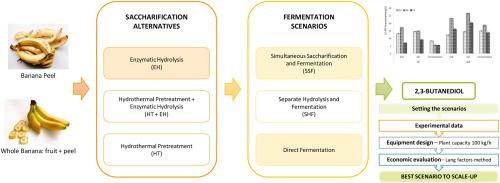当前位置:
X-MOL 学术
›
Biomass Bioenergy
›
论文详情
Our official English website, www.x-mol.net, welcomes your feedback! (Note: you will need to create a separate account there.)
Bio-2,3-butanediol production from banana waste: Preliminary techno-economic evaluation of processing strategies
Biomass & Bioenergy ( IF 5.8 ) Pub Date : 2024-04-17 , DOI: 10.1016/j.biombioe.2024.107218 Marina Fernández-Delgado , Mercedes Rodríguez-Sarmiento , Jesus David Coral Medina , Susana Lucas , M. Teresa García-Cubero , Mónica Coca , Juan Carlos López-Linares
Biomass & Bioenergy ( IF 5.8 ) Pub Date : 2024-04-17 , DOI: 10.1016/j.biombioe.2024.107218 Marina Fernández-Delgado , Mercedes Rodríguez-Sarmiento , Jesus David Coral Medina , Susana Lucas , M. Teresa García-Cubero , Mónica Coca , Juan Carlos López-Linares

|
This study evaluates different fermentation strategies to produce 2,3-butanediol (2,3-BD) from banana industry waste, such as whole bananas (fruit + peels) and banana peels, selecting the most favorable from a technical and economic point of view. Both residues have enough free sugars (17.8 %–35.8 %), glucan (11.0 %–14.2 %) and hemicellulose (2.8 %–6.3 %), to be promising substrates for 2,3-BD fermentation. Saccharification was studied by comparing enzymatic hydrolysis, hydrothermal pretreatment, and hydrothermal pretreatment followed by enzymatic hydrolysis. Different fermentation scenarios were also compared regarding the 2,3-BD yield and productivity: Separate Hydrolysis and Fermentation (SHF), Simultaneous Saccharification and Fermentation (SSF), and direct fermentation without prior saccharification using DSM-365 as the fermenting microorganism. The results showed that the pretreatment step was not necessary to improve the release of fermentable sugars. Enzymatic hydrolysis was the most effective alternative for maximizing sugar recovery, reaching sugar concentrations of 18.1 g/L (recovery: 92.5 %) for banana peels and 33.3 g/L (recovery: ∼100 %) for whole bananas. The SSF strategy led to higher 2,3-BD concentrations of 15.0 g/L and 26.6 g/L for banana peels and whole bananas, respectively. The preliminary economic analysis indicated that SSF and direct fermentation could be the more cost-effective process alternatives for banana peels and whole bananas, respectively. Thus, it was demonstrated that banana waste is an interesting resource for the production of 2,3-BD. The bioprocess can be competitive when using a low-cost raw material and reducing the number of process steps compared to traditional technologies.
中文翻译:

利用香蕉废物生产生物 2,3-丁二醇:加工策略的初步技术经济评估
本研究评估了从香蕉工业废料(例如整根香蕉(水果+皮)和香蕉皮)生产 2,3-丁二醇 (2,3-BD) 的不同发酵策略,从技术和经济角度选择最有利的策略。两种残渣都含有足够的游离糖 (17.8 %–35.8 %)、葡聚糖 (11.0 %–14.2 %) 和半纤维素 (2.8 %–6.3 %),是 2,3-BD 发酵的有希望的底物。通过比较酶水解、水热预处理和水热预处理后酶水解来研究糖化。还比较了不同发酵方案的 2,3-BD 产量和生产率:单独水解和发酵 (SHF)、同时糖化和发酵 (SSF) 以及使用 DSM-365 作为发酵微生物而无需事先糖化的直接发酵。结果表明,预处理步骤对于提高可发酵糖的释放不是必需的。酶水解是最大限度提高糖回收率的最有效替代方法,香蕉皮的糖浓度达到 18.1 g/L(回收率:92.5%),整根香蕉的糖浓度达到 33.3 g/L(回收率:∼100%)。 SSF 策略导致香蕉皮和整根香蕉的 2,3-BD 浓度分别达到 15.0 g/L 和 26.6 g/L。初步经济分析表明,SSF 和直接发酵可能分别是香蕉皮和整根香蕉更具成本效益的工艺替代方案。因此,这表明香蕉废物是生产 2,3-BD 的一种有趣的资源。与传统技术相比,生物工艺在使用低成本原材料并减少工艺步骤数量时具有竞争力。
更新日期:2024-04-17
中文翻译:

利用香蕉废物生产生物 2,3-丁二醇:加工策略的初步技术经济评估
本研究评估了从香蕉工业废料(例如整根香蕉(水果+皮)和香蕉皮)生产 2,3-丁二醇 (2,3-BD) 的不同发酵策略,从技术和经济角度选择最有利的策略。两种残渣都含有足够的游离糖 (17.8 %–35.8 %)、葡聚糖 (11.0 %–14.2 %) 和半纤维素 (2.8 %–6.3 %),是 2,3-BD 发酵的有希望的底物。通过比较酶水解、水热预处理和水热预处理后酶水解来研究糖化。还比较了不同发酵方案的 2,3-BD 产量和生产率:单独水解和发酵 (SHF)、同时糖化和发酵 (SSF) 以及使用 DSM-365 作为发酵微生物而无需事先糖化的直接发酵。结果表明,预处理步骤对于提高可发酵糖的释放不是必需的。酶水解是最大限度提高糖回收率的最有效替代方法,香蕉皮的糖浓度达到 18.1 g/L(回收率:92.5%),整根香蕉的糖浓度达到 33.3 g/L(回收率:∼100%)。 SSF 策略导致香蕉皮和整根香蕉的 2,3-BD 浓度分别达到 15.0 g/L 和 26.6 g/L。初步经济分析表明,SSF 和直接发酵可能分别是香蕉皮和整根香蕉更具成本效益的工艺替代方案。因此,这表明香蕉废物是生产 2,3-BD 的一种有趣的资源。与传统技术相比,生物工艺在使用低成本原材料并减少工艺步骤数量时具有竞争力。











































 京公网安备 11010802027423号
京公网安备 11010802027423号